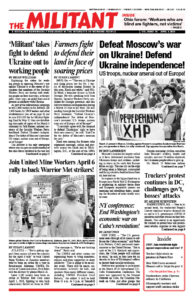HAGERSTOWN, Md. — Now in its second week, the trucker-led People’s Convoy continues to press demands for an end to U.S. government COVID-19 mandates and other attacks on their livelihoods. The convoy is an opportunity for truckers to protest boss and government attacks, organize to win support and join in widespread political discussion.
Many truckers believe — correctly — that the liberal media is working overtime to smear the convoy as rightist and dangerous. The press has featured commentary by self-appointed “extremism researchers” who write about truckers’ “sinister strategies” that can lead to “overt violence.” Meanwhile, the daily loops around the beltway and efforts to present their demands at the U.S. Capitol are organized and orderly.
“I was just interviewed by the New York Times, but we’ll see how they spin it,” Wes Short, a steel hauler from Jefferson, Ohio, told this Militant worker-correspondent March 16. “I can guarantee that this fact won’t be in the article — everything you need is moved by a trucker.”
Short was correct. Times reporter Charles Homans claimed the truckers “are fueled by a far broader set of right-wing grievances.”
“The government and the media are smearing the truckers the same way they do striking workers,” Socialist Workers Party member Arrin Hawkins told Short. “The SWP and the Militant are getting out the truth and organizing solidarity. The working class has a stake in truckers winning some relief.”
The orderly and well-maintained “camp” at the sprawling Hagerstown Speedway, which offers three hot meals a day and even a barber shop, is organized by volunteers. Security teams welcome participants and explain the protest is civil, peaceful and open to different points of view, of which there are many.
“We want a better life for our families,” Adria “Hippie” Louis told us. Louis, a mother of seven whose husband is a trucker, organizes the day-to-day operations at the speedway. She pointed with pride to pallets of donated food, water and other supplies.
“I never thought in my life I would see $6 for diesel,” independent operator Aaron Simmons, 43, from Oskaloosa, Iowa, told us. “I tell my family and friends get ready, because when diesel goes up, everything goes up.”
Simmons explained that after six years as a company driver, he became an independent operator two years ago. “Because of the ‘freedom.’ I could work for myself. Now I’m not so sure.” Simmons says he’s been out of work for almost three weeks waiting for parts to repair his rig, with a price tag of $8,000 to $9,000.
The majority of the owner-operators are workers who decided to sink their life savings, and whatever they could borrow, into buying a truck or two. Others lease their rigs from government-licensed carriers who, along with unscrupulous brokers, set the trucking rates. They pay the drivers a percentage after skimming profits off the top. Out of the portion they’re paid, the truckers must cover all the costs of fuel, repairs, insurance, taxes, loan repayment and more.
Crisis facing truckers today
The crisis the owner-operators face today is the result of the lawful working of the capitalist system, aided and abetted by the pro-boss policies of the government. A turning point came under the administration of Jimmy Carter, when he signed the Motor Carriers Act in 1980 deregulating the trucking industry.
Deregulation wasn’t meant to help truckers. It turned what had been a largely Teamster union-organized industry into a dog-eat-dog scrum of nonunion bosses and cutthroat competition. The Teamsters union had fought for and won national union contracts with hourly pay, cost-of-living increases, health care and pension benefits. After deregulation, union membership fell from over 2 million truckers in 1974, to 75,000 in 2018.
For decades truckers in the industry have seen their wages decline as much as 50%, while their workweek grew longer and longer. The 2020 median annual wage for the 1.9 million U.S. truckers is $45,260, with the newest and worst paid earning less than $30,600 a year. Paid by the mile, one in five truckers are on the road 75 hours per week. They face hours of unpaid time waiting while their truck is loaded and unloaded or refueling, or while filling out onerous paperwork. Almost 40% have no health care. A whopping 91% of truckers quit their jobs in 2019.
“I feel for my friends just starting out. A CDL license and a couple weeks training is not the same as experience. I had my grandfather and my father who were truckers, and that helped a lot. I had two months training,” David Brooks, 35, an owner-operator from Charlotte, North Carolina, said at a truck stop here.
“The boss is pushing you all the time. ‘Hey, Google says you can make this run in five hours, what’s your problem.’ You’re in a pressure cooker with all the government regulations,” he said. “The owner-operators and the fleet drivers, we are the same, facing the same problems.”
“In the 1930s, truckers gained experience in the class struggle. A quarter of a million over-the-road truckers were organized into the Teamsters union, which reached out to them as fellow workers,” Hawkins said. “The Socialist Workers Party was part of the leadership of that union effort.” Brooks got a subscription to the Militant and a copy of Malcolm X, Black Liberation, and the Road to Workers Power by SWP National Secretary Jack Barnes.

